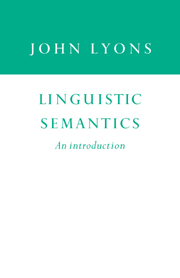Book contents
- Frontmatter
- Contents
- Preface
- List of symbols and typographical conventions
- Part 1 Setting the scene
- Part 2 Lexical meaning
- Part 3 Sentence-meaning
- Part 4 Utterance-meaning
- 8 Speech acts and illocutionary force
- 9 Text and discourse; context and co-text
- 10 The subjectivity of utterance
- Suggestions for further reading
- Bibliography
- Index
8 - Speech acts and illocutionary force
Published online by Cambridge University Press: 05 June 2012
- Frontmatter
- Contents
- Preface
- List of symbols and typographical conventions
- Part 1 Setting the scene
- Part 2 Lexical meaning
- Part 3 Sentence-meaning
- Part 4 Utterance-meaning
- 8 Speech acts and illocutionary force
- 9 Text and discourse; context and co-text
- 10 The subjectivity of utterance
- Suggestions for further reading
- Bibliography
- Index
Summary
INTRODUCTION
So far we have not exploited to any significant degree the terminological distinction between ‘sentence’ and ‘utterance’ that was introduced in Chapter 1. Nor have we exploited the associated distinctions between Saussure's ‘langue’ and ‘parole’ and Chomsky's ‘competence’ and ‘performance’, which, as we saw in Chapter 1, need to be reformulated, as non-equivalent dichotomies within the system–process–product trichotomy, if we are to avoid the confusion that exists in the account that is given of these technical distinctions in most textbooks.
Much of the work that has been done in formal semantics (in so far as it has been applied to the analysis of natural languages) has been based on the view that languages are sets of sentences and that sentences are used primarily, if not exclusively, to make descriptive statements. Typically, therefore, no distinction is drawn in formal semantics between sentence-meaning and propositional (i.e., descriptive) content. This is clearly a very limited view of what a language is and (as we saw in Chapter 6) of sentence-meaning. It is a view that has been much criticized.
One of the most influential critics in recent years was the Oxford philosopher, J. L. Austin (1911–60), whose ideas have been much discussed, not only by philosophers, but also by linguists (and representatives of many other disciplines). In this chapter, we use Austin's theory of so-called speech acts as a departure-point for the analysis of utterance-meaning that follows in Chapters 9 and 10.
- Type
- Chapter
- Information
- Linguistic SemanticsAn Introduction, pp. 234 - 257Publisher: Cambridge University PressPrint publication year: 1995



